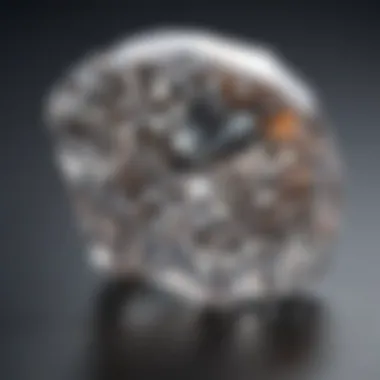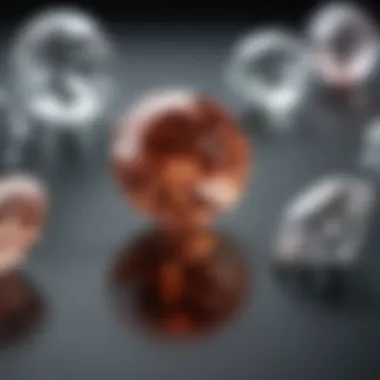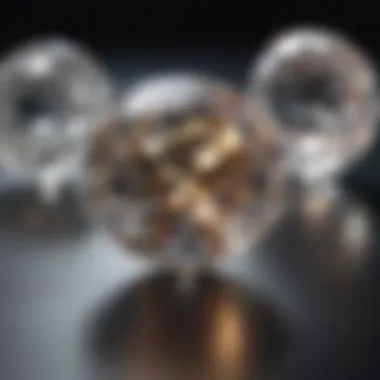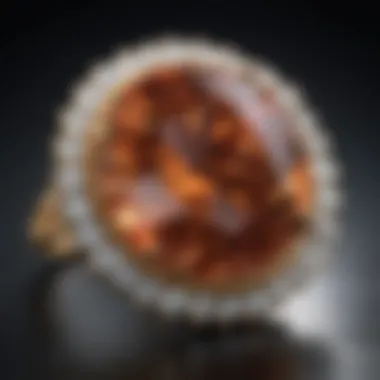Understanding Lab-Created Diamonds: Authentic or Fake?


Intro
The rise of lab-created diamonds has shifted the landscape of gemology and jewelry. Many individuals question whether these stones are genuine or simply imitations. This article addresses these queries by examining the processes behind lab-created diamonds, their properties, and their standing in the marketplace. Readers will gain an understanding of the differences between lab-created and natural diamonds, helping them make informed purchasing decisions.
Gemstone Overview
Definition and characteristics
Lab-created diamonds are real diamonds, chemically and physically identical to their mined counterparts. Both are composed of carbon atoms arranged in a crystal structure. Synthetic diamonds share the same brilliance and hardness, rated at 10 on the Mohs scale. This hardness makes them suitable for everyday wear and helps them maintain their beauty over time.
Classification of gemstones
Gemstones fall into two main categories: precious and semi-precious. Natural diamonds belong to the precious category, renowned for their rarity and desirability. Lab-created diamonds, while equally exquisite, are often classified as semi-precious due to their production processes. Despite this classification, many consumers and jewelers have begun to appreciate lab-created stones for their environmental and ethical advantages.
Properties of Gemstones
Physical properties
The physical properties of diamonds, be they lab-created or natural, are impressive. They exhibit high refractive indices, contributing to their brilliance and fire. The absence of inclusions or any significant flaws gives these stones a clarity that enhances their value and appeal. Other physical properties include durability, as these gems withstand scratches and wear effectively.
Chemical properties
Chemically, both types of diamonds consist of pure carbon. This similarity extends to their atomic structure, which dictates their physical characteristics. Various processes, such as High Pressure High Temperature (HPHT) and Chemical Vapor Deposition (CVD), are utilized in creating lab diamonds. These methods replicate natural diamond formation, resulting in genuinely authentic gems.
"Lab-created diamonds are not fake; they are simply formed in controlled environments that expedite the same natural processes."
Understanding these essential aspects is crucial for collectors and jewelry enthusiasts. They can appreciate the full potential and value behind lab-created diamonds as they continue to gain acceptance in the broader marketplace.
Intro to Diamonds
Diamonds hold a unique place in our culture and economy. They symbolize luxury, endurance, and beauty. Understanding diamonds is essential, especially when comparing lab-created and natural options. This section will outline what diamonds are, touching on their definitions, origins, and characteristics.
Definition of Diamonds
Diamonds are crystalline forms of carbon, renowned for their exceptional hardness. They form under high-pressure conditions occurring deep within the Earth over millions of years. The process requires both time and specific environmental factors, contributing to their status as prized gemstones.
A diamond's allure extends beyond its physical properties. Its clarity, color, cut, and carat weight influence its value and desirability. Each of these elements contributes to a diamond's overall appeal, making understanding them critical for buyers and enthusiasts.
Natural vs. Synthetic Diamonds
The distinction between natural and synthetic diamonds is significant. Natural diamonds emerge from geological processes, while synthetic diamonds are engineered in laboratories. Despite their different origins, both types possess similar physical and chemical properties.
However, perceptions around these diamonds can differ vastly. Natural diamonds often carry inherent value due to their long history and rarity. In contrast, lab-created diamonds are viewed by some as less authentic. This misconception can impact purchasing decisions.
Understanding these differences is crucial, especially in today’s market where consumer preferences and ethical considerations are changing. Knowledge of where diamonds come from and how they are made enriches the dialogue about authenticity and value.
What are Lab-Created Diamonds?


Lab-created diamonds, also known as synthetic or cultured diamonds, are gems that possess the same physical, chemical, and optical properties as natural diamonds. Their significance in the jewelry market is growing. Knowing what lab-created diamonds are can help buyers make better choices. In this section, we delve into their formation processes and the materials used in their creation to understand them better.
Formation Process
The creation of lab-created diamonds involves complex processes designed to mimic natural diamond formation in a controlled environment. Two prominent methods are used in the industry: High Pressure High Temperature (HPHT) and Chemical Vapor Deposition (CVD).
High Pressure High Temperature (HPHT)
High Pressure High Temperature (HPHT) is one technique where diamond is formed under conditions that resemble those in the Earth’s mantle. This involves intense pressure and high temperatures to convert carbon into diamond. The key characteristic of HPHT is its efficiency. It can produce diamonds quickly when compared to natural processes that take billion of years.
One unique feature of HPHT is that it can also create diamonds in a variety of colors, which adds an aesthetic appeal. Moreover, it can yield larger stones in a shorter time. However, this method does have some disadvantages. HPHT diamonds can display different inclusions compared to natural diamonds. Some may argue that this process lacks the time-tested authenticity of natural diamonds.
Chemical Vapor Deposition ()
Chemical Vapor Deposition (CVD) is another approach that has gained traction in the creation of synthetic diamonds. In this method, a gas mixture containing carbon is put in a vacuum chamber. The gas molecules are energized, causing them to deposit onto a substrate, forming diamond layer by layer. A key characteristic of CVD diamonds is their purity; they tend to have fewer impurities, impacting not just their visual quality but also their durability.
CVD diamonds are popular due to their precision in being tailored to specific characteristics, such as clarity and color. One notable advantage of this method is its sustainability. The process can use lower amounts of energy compared to HPHT. On the downside, CVD diamonds can take longer to produce, which might create potential supply chain challenges.
Materials Used
The materials utilized in creating lab-created diamonds are predominantly carbon-based. High standard purity is essential for optimal diamond formation. The carbon source is critical, as it impacts the stone's final quality. In HPHT, natural graphite is often used, which is readily available. In contrast, CVD relies on specific gases, ensuring a high degree of control and cleanliness in the process.
Understanding these materials is essential for both jewelers and customers. They directly relate to the diamond's quality, price, and ultimately its perceived authenticity. The more consumers know about the materials, the better their choices will be in selecting a diamond that meets their expectations.
"Lab-created diamonds are not just alternatives; they represent a new standard in sustainable luxury," says gemologists in the diamond industry.
Evaluating Diamond Authenticity
In the realm of gemstones, evaluating diamond authenticity holds a pivotal role. Differentiating lab-created diamonds from natural ones is essential for buyers and collectors. As the market for lab-created diamonds expands, understanding what certifies a diamond's authenticity becomes increasingly important. Consumers want to ensure that their investment is genuine, particularly in a landscape where distinctions can be subtle yet significant.
This article part will delve into two primary sub-sections: gemological certifications and distinguishing features unique to lab-created diamonds. Both areas provide valuable insights into the characteristics and verifications that set diamonds apart.
Understanding Gemological Certifications
Gemological certifications serve as the cornerstone for establishing a diamond’s authenticity. These certifications are provided by recognized gemological laboratories such as the Gemological Institute of America (GIA) or the International Gemological Institute (IGI). A certified diamond comes with a grading report that outlines its characteristics, including carat weight, cut, color, and clarity.
When it comes to lab-created diamonds, the importance of certifications amplifies. Since both lab-created and natural diamonds share identical chemical structures, a certified grading report can clarify any confusion. Consumers should always seek diamonds that come with these certifications to ensure they understand what they are purchasing. This report can reveal whether the diamond is a lab creation or a natural product.
Some things to look for on a gemological certificate:
- The type of diamond
- The specific grading details
- The lab's credibility
Having a gemological grade is not only beneficial for resale value but it also aids in insurance matters, ensuring that the diamond's provenance is established.
Distinguishing Features of Lab-Created Diamonds
Lab-created diamonds possess unique identifying characteristics, which differ slightly from their natural counterparts. Although both types are virtually indistinguishable to the naked eye, specific features can help distinguish them when inspected closely. One of the primary indicators is the presence of growth patterns. Lab-created diamonds often exhibit different growth patterns due to their formation processes, including High Pressure High Temperature (HPHT) or Chemical Vapor Deposition (CVD).
Additional features may include:


- Inclusions: Lab-created diamonds may contain less common inclusions, helping to identify them upon thorough examination.
- Fluorescence: Their response to ultraviolet light could also differ significantly, which is a point of examination for gemologists.
Understanding these features empowers consumers and collectors. By being informed, they can avoid costly mistakes when purchasing a diamond. The focus on authentication is made even more critical by the evolving market, meaning buyers must remain vigilant and informed.
"A well-certified diamond sets the stage for informed purchasing decisions and peace of mind."
Overall, the evaluation of diamond authenticity is fundamental in the world of gemstones. Buyers can appreciate the value and nature of their purchase better while ensuring their investment is secure.
Perceptions of Lab-Created Diamonds
The perceptions surrounding lab-created diamonds play a significant role in understanding their place in the modern jewelry market. These perceptions are shaped by various factors, including societal beliefs, media influence, and personal experiences. Addressing these perceptions is crucial for assessing the overall acceptance of lab-created diamonds among consumers, jewelers, and industry experts.
When consumers consider purchasing a diamond, they often weigh the options between natural and lab-created stones. The reputation of lab-created diamonds has evolved over recent years, with a growing number of individuals acknowledging their equivalency to natural diamonds. This shift in perception is often due to increased awareness about their ethical production methods and similar qualities. The importance of this topic cannot be understated, as it not only influences personal buying decisions but also impacts market trends and pricing dynamics.
Market Sentiment
Market sentiment regarding lab-created diamonds appears to show a gradual warming. Increasing numbers of consumers are now open to purchasing these stones, viewing them as a more responsible and affordable option compared to their natural counterparts. Reports indicate that millennials and Gen Z are particularly receptive to lab-created options, valuing transparency and ethical considerations over the prestige that traditionally accompanies natural diamonds.
The jewelry industry is responding to this shift, incorporating lab-created diamonds into their offerings. Many jewelers now offer both options side by side, enabling consumers to choose based on value and ethical considerations.
- Factors influencing market sentiment:
- Affordability: Lab-created diamonds typically cost 20-40% less than natural diamonds.
- Ethical production: Concerns about conflict diamonds drive consumers toward lab-created alternatives.
- Quality Assurance: Lab-created diamonds exhibit similar physical and chemical properties to natural stones.
"The growing acceptance of lab-created diamonds is changing the landscape of the jewelry market, highlighting the importance of sustainable choices."
Consumer Attitudes
Consumer attitudes towards lab-created diamonds are shaped by individual values, knowledge, and experiences. Many consumers perceive lab-created diamonds as an appealing choice due to their environmental benefits and lower price points. Yet, there remains an undercurrent of skepticism among certain segments of the population, who consider lab-created stones as lesser substitutes for natural diamonds. This perception stems from the long-held belief that a diamond's value is tied to its natural origins.
The educational component becomes essential in this space. As consumers acquire more information regarding lab-created diamonds, attitudes tend to shift. Jewelers who promote these stones typically provide details about their creation processes and ethical advantages, helping to dispel myths regarding their authenticity.
- Positive consumer attitudes:
- Sustainability: Awareness about environmental issues drives interest in lab-created options.
- Value for money: Many buyers appreciate the aesthetics without the high price tag.
- Personal significance: Lab-created diamonds can symbolize personal values more closely than mined stones.
In summary, perceptions of lab-created diamonds are fluid and influenced by various factors. Understanding these market sentiments and consumer attitudes provides a deeper insight into the complexities of this emerging segment of the diamond industry.
Pricing Dynamics
The dynamics of pricing lab-created diamonds play a crucial role in understanding their place in the market. With the rise of these man-made alternatives, consumers and industry professionals must come to terms with various factors that influence their costs. The differences in pricing are not just about numbers but reflect broader issues, including craftsmanship, technology, ethical sourcing, and market trends. Understanding these pricing elements can significantly impact purchasing decisions for buyers, as well as inform sellers and jewelers about how to position their offerings effectively.
Cost Comparison: Natural vs. Lab-Created
When one compares the costs of natural diamonds to lab-created diamonds, the disparity is often striking. Generally, lab-created diamonds can cost 20% to 40% less than their natural counterparts. This price variation is attributed to several factors:
- Production Costs: Lab-created diamonds are produced using high-pressure and high-temperature (HPHT) or chemical vapor deposition (CVD) methods. These processes can be less expensive than mining natural diamonds, leading to lower retail prices.
- Market Demand and Supply: The demand for lab-created diamonds has increased, but the supply chain is also more stable compared to natural diamonds, where geopolitical issues can affect mining operations. This efficiency in supply leads to more competitive pricing.
- Perceived Value: Natural diamonds carry an emotional and historical weight that often elevates their cost. Consumers may favor natural diamonds because of their rarity, which can affect market pricing. Conversely, lab-created diamonds can struggle against this perception, despite possessing identical qualities.


In essence, the cost comparison serves as a critical consideration for consumers. Those looking for value may lean towards lab-created options, while others may prioritize tradition and rarity that natural diamonds signify.
Market Availability and Supply
Market availability and supply of lab-created diamonds bring significant advantages to consumers and retailers alike. The expansion of lab-grown diamonds has been pivotal in democratizing access to quality gemstones. Notably, the supply chain for these diamonds often remains stable and consistent, allowing retailers to meet consumer demand more readily.
Key aspects of market availability include:
- Widespread Distribution: Lab-created diamonds are available through various retailers both online and offline. The growing acceptance of these creations means that consumers have more options to choose from compared to the traditionally exclusive market of natural diamonds.
- Reliable Consistency: With controlled production methods, lab-created diamonds can provide consistent quality in terms of size, color, and clarity. This predictability aids retailers in managing inventory efficiently.
- Sustainability and Ethics: The aspect of ethical sourcing and environmental impact can sway consumers towards lab-created diamonds. Many buyers are now more informed and conscientious about the sources of their jewelry, making the ethical appeal of lab-created stones a selling point.
Lab-Created Diamonds and Ethics
The conversation around lab-created diamonds often extends beyond just their physical properties and pricing. The ethical implications of producing these gems have increasingly shaped consumer perception and the broader market dynamics. This section explores the ethical considerations surrounding lab-created diamonds, including their environmental impact and conflict-free assurances.
Environmental Impact
Lab-created diamonds are frequently touted as a more sustainable alternative to their natural counterparts. Traditional diamond mining is a resource-intensive activity that often results in significant environmental degradation. The extraction process can lead to habitat destruction, soil erosion, and pollution of nearby water sources. In contrast, lab-created diamonds require fewer raw materials and typically consume less energy.
The processes used to create diamonds in a laboratory setting, such as High Pressure High Temperature (HPHT) and Chemical Vapor Deposition (CVD), generate a smaller ecological footprint. For instance, during CVD, methane is utilized, and the greenhouse gas emissions are significantly lower when compared to the emissions produced during mining activities. Moreover, the energy used to produce lab-created diamonds can come from renewable sources, further mitigating their environmental impact.
It is important to note, however, that lab-created diamonds are not entirely without environmental cost. The electricity required for diamond synthesis and the resources used in the cooling and transportation process still have some level of impact on the environment. Thus, while lab-created diamonds present a more eco-friendly option, consumers need to consider these factors in their decision-making.
Conflict-Free Assurance
The issue of conflict diamonds has cast a long shadow over the gem industry. Natural diamonds sourced from regions engaged in armed conflict or human rights abuses have raised serious ethical concerns. The Kimberley Process was established to prevent the sale of these conflict diamonds, but its effectiveness and enforcement are often questioned.
Lab-created diamonds, by their nature, eliminate the conflict diamond dilemma. Because they do not originate from mined sources, their provenance is clear and transparent. Consumers can purchase lab-created diamonds with a higher degree of confidence that their purchase does not support unethical practices.
"Lab-created diamonds offer peace of mind to consumers who are increasingly conscious about the ethical implications of their purchases."
Furthermore, many companies that produce lab-created diamonds emphasize their commitment to ethical practices. They often provide certifications that underscore their compliance with industry standards, reinforcing the notion that purchasing lab-created diamonds contributes to ethical consumerism.
In summary, both environmental impact and conflict-free assurances are significant elements within the broader narrative of lab-created diamonds. These considerations provide consumers with a more comprehensive view, enabling them to make informed and conscientious choices in the marketplace.
Ending
The conclusion serves as the final space to synthesize the information presented throughout this article. It is crucial for understanding the implications and interpretations of lab-created diamonds in the broader context of the gemstone market. As discussions about authenticity, ethics, and economic impact become increasingly relevant, this summary will encapsulate the essential points raised.
Summary of Key Points
In reviewing lab-created diamonds, several core themes emerge that warrant attention:
- Definitions Matter: Distinguishing between natural and lab-created diamonds is fundamental. Both are chemically and physically identical, yet their origins differ significantly.
- Creation Processes: The two primary methods of lab-created diamond formation—High Pressure High Temperature (HPHT) and Chemical Vapor Deposition (CVD)—illustrate the advanced technology behind these stones. Understanding these processes enhances appreciation for their craftsmanship.
- Authenticity and Certification: A gemological certification is vital to confirm the quality and origin of any diamond, whether natural or lab-grown. Consumers should always request this documentation.
- Consumer Sentiment: Among consumers and jewelers alike, opinions vary. While some embrace lab-created diamonds for their ethical dimensions, others hold firm to a preference for natural stones.
- Economic Considerations: Lab-created diamonds typically cost less than natural diamonds, affecting accessibility and consumer choices. This price dynamic plays a role in public perception and market trends.
- Ethical Implications: Lab-created diamonds offer a transparent alternative to natural diamonds. They present fewer environmental concerns and are assuredly conflict-free, appealing to conscious consumers.
Final Thoughts on the Authenticity Debate
The question of authenticity surrounding lab-created diamonds is multifaceted. On one hand, skeptics argue that lab-grown stones lack the historical significance associated with natural diamonds. They associate value with the natural process and the rarity of mined diamonds. On the other hand, proponents advocate for the benefits lab-created diamonds bring to modern society, emphasizing innovation and ethical sourcing.
As we navigate through this complex debate, it is essential to focus on individual consumer priorities. For those who value eco-friendliness and cost-effectiveness, lab-created diamonds present a compelling option. Conversely, individuals who prioritize tradition may continue to prefer natural diamonds despite their political and environmental issues.
Ultimately, the quality and authenticity of the stone should guide purchasing decisions. It is beneficial for consumers to be armed with knowledge, enabling informed choices that align with their values. The evolution of lab-created diamonds is a phenomenon worth watching as it challenges existing paradigms in the gemstone industry.
"Diamonds, whether natural or lab-created, hold a unique allure, but it is our understanding that defines their true worth."
As awareness grows, the distinctions will blur, and the debate will continue to be shaped by cultural shifts and consumer preferences.



